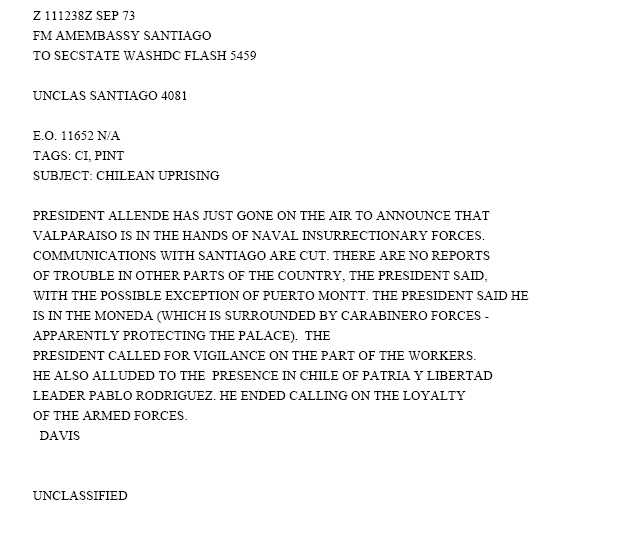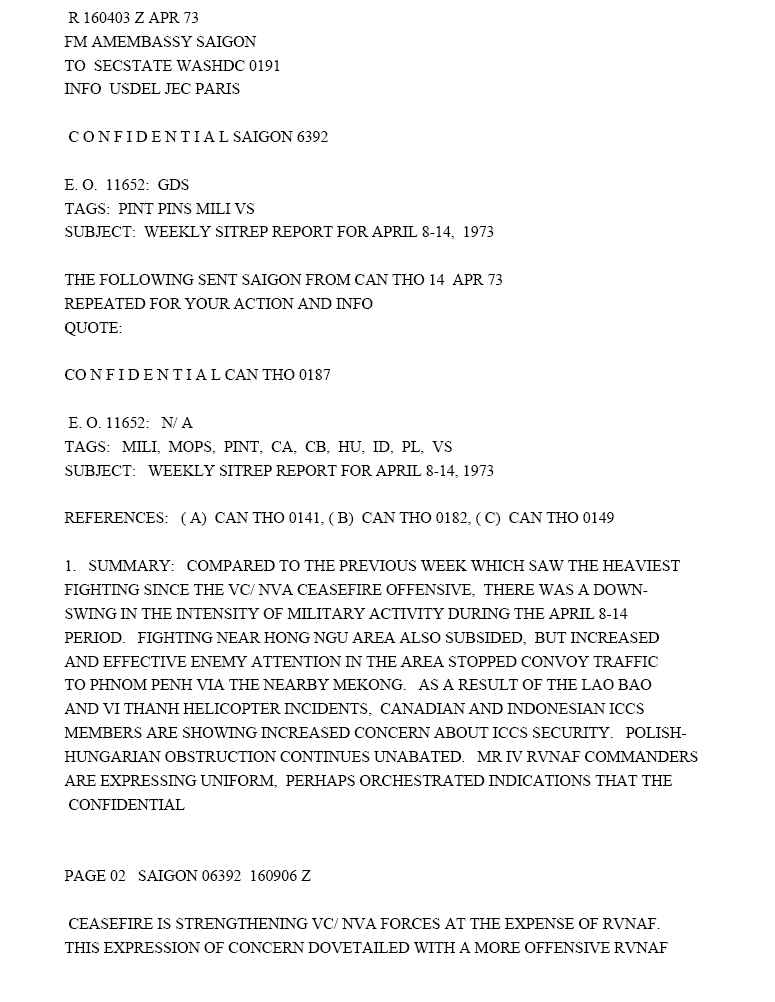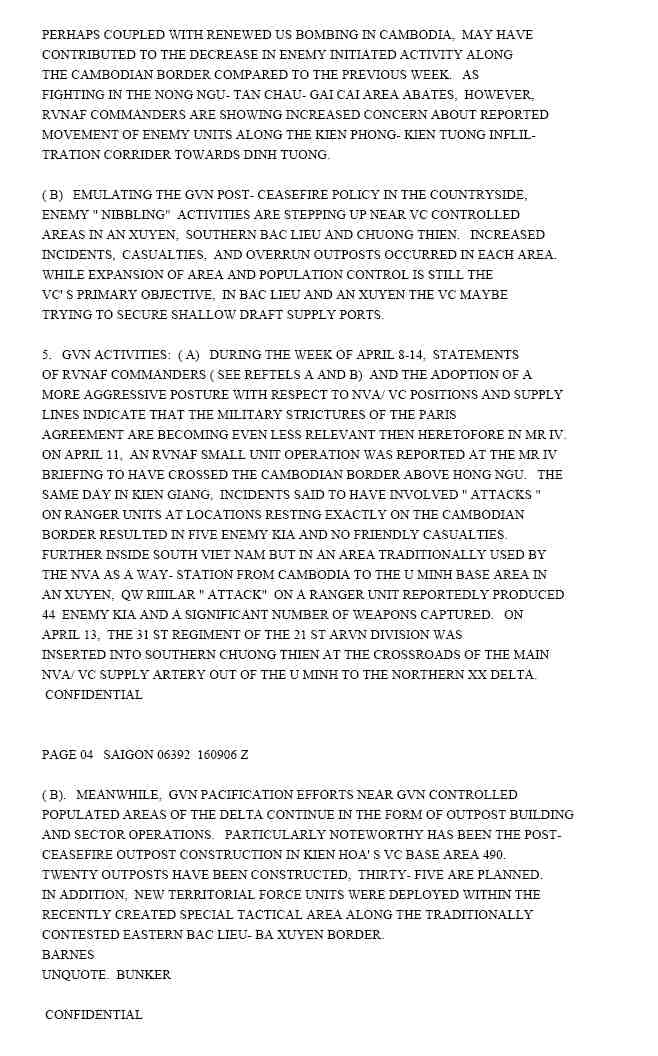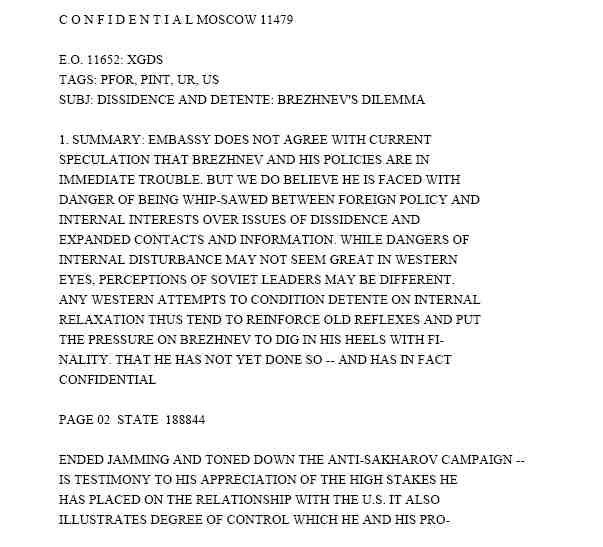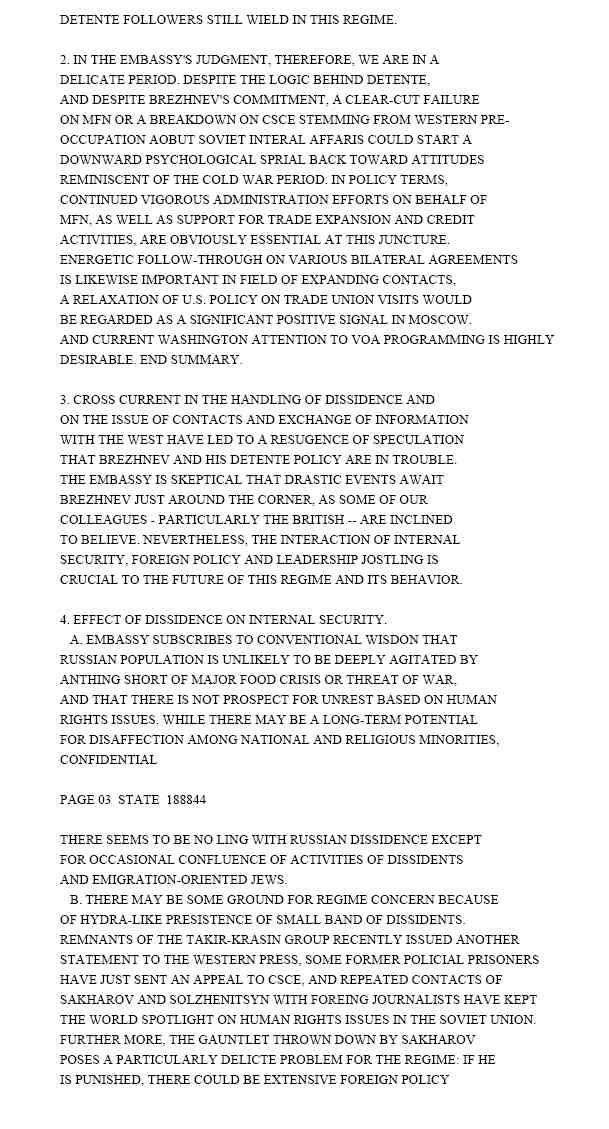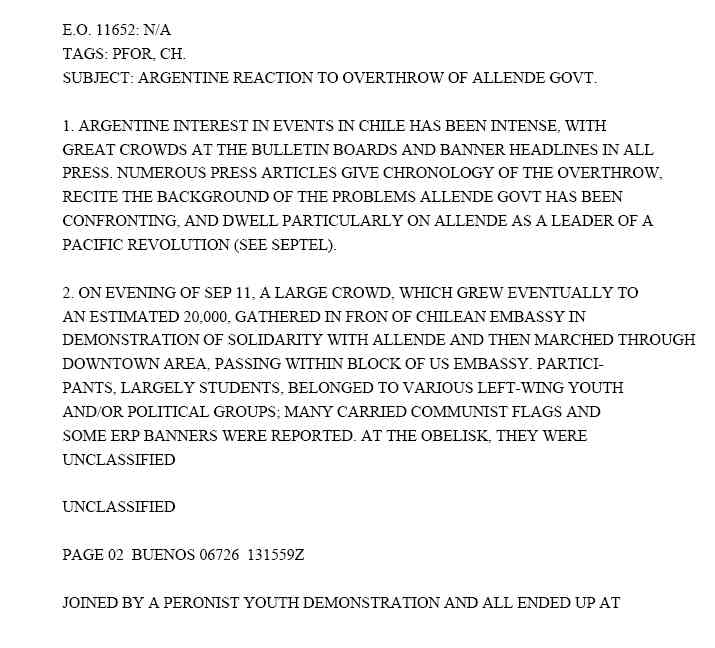|
Department of State Electronic Telegrams: 1973 - 1974
897,000 pages of electronic telegramn information, including 559,000 pages of State Department telegrams, plus 292,400 pages of descripyion/attribution sheets.
State Department Cables from the Department of State Central Foreign Policy File, dating from April 1973, to December 31, 1974.
These records are popularly known as the "State Department Cables" or the "State Department Telegrams." This collection contains the fully releasable telegrams determined to have permanent historical value that could be exported from the contemporary Department of State Archiving System [SAS].
The materials relate to all aspects of American bilateral and multilateral foreign relations and routine administrative and operational activities of the Department of State and its Foreign Service posts. The telegrams convey official information about policy proposals and implementation, program activities, or personnel and post operations between the Department of State and posts abroad. After telegrams were transmitted, they were preserved in a central database that contained the text of the telegrams.
Each text file record potentially contains the following types of information: concepts; date; drafter; who the telegram is from; office; subject; Traffic Analysis by Geography and Subject (TAGS); who the telegram is to; message number; and message. The series also includes records such as airgrams, memoranda, correspondence, reports, diplomatic notes, and related material that documented Department of State policies in the Central Foreign Policy Files.
Vietnam War
Telegrams include 6,492 telegrams to and from the U.S. embassy in Saigon.
Topics include: Embassy reports concerning the current situation with the ceasefire. Plans for economic assistance to the government of Vietnam. Progress of Operation Homecoming and the return of prisoners of war. Military assistance to the Republic of Vietnam. Reports of skirmishes between North and South Vietnam forces. The escalation of Viet Cong violence. Security for American personnel in Vietnam. Preparations incase of the necessity to evacuate the embassy.
Soviet Union
Telegrams include 12,345 telegrams to and from the U.S. embassy in Moscow.
Topics include: The Strategic Arms Limitation Talks II. SALT II was a second round of talks from 1972 to 1979 between the U.S. and Soviet Union, which sought to curtail the manufacture of strategic nuclear weapons. It was a continuation of progress made during the SALT I talks. The Nixon - Brezhnev summit meetings. Space cooperation and the planning for the Apollo-Soyuz joint space mission. Developments concerning Jewish emigration.
Henry Kissinger
Telegrams include 50,860 telegrams to, from, and mentioning Henry Kissinger. The telegrams cover a period of time in which Henry Kissinger served concurrently as both Assistant to the President for National Security Affairs, commonly referred to as the National Security Advisor, and as United States Secretary of State. During this time, Kissinger was pioneering the policy of détente that led to a significant relaxation in U.S.�Soviet tensions. In 1973, Kissinger negotiated the end to the Yom Kippur War, which had begun with a surprise attack against Israel by Egyptian and Syrian forces.
The many international and domestic events occurring during the period of time covered by the telegrams include:
July 16, 1973 - Watergate Scandal: Former White House aide Alexander Butterfield informs the United States Senate Watergate Committee, that President Richard Nixon had secretly recorded potentially incriminating conversations.
August 1973 - The U.S. bombing of Cambodia ends, marking the official halt to 12 years of combat activity in Southeast Asia.
September 11, 1973 - Chile's democratically-elected government is overthrown in a military coup after serious instability. President Salvador Allende dies, and General Augusto Pinochet heads a U.S.-backed military junta that will govern Chile for the next 16 years.
October 6, 1973 - Yom Kippur War: The fourth and largest Arab-Israeli conflict begins, as Egyptian and Syrian forces attack Israel on Yom Kippur.
October 22, 1973 - Egypt defects to the American camp by accepting a U.S. cease-fire proposal during the October 1973 war.
October 17, 1973 - The Arab Oil Embargo against several countries which supported Israel triggers the 1973 energy crisis.
November 25, 1973 - Greek Dictator George Papadopoulos is ousted in a military coup led by Lieutenant General Phaidon Gizikis.
January 1974 - Though they are still too weak to launch a full-scale offensive, the North Vietnamese have rebuilt their divisions in the South, and have captured key areas.
April 1974 - The Angolan Civil War. This conflict devastated newly-independent Angola following the end of Portuguese colonial rule in April 1974. It became Africa's longest running conflict. Formally brought to an end in 2002, an estimated 500,000 people were killed and tens of thousands more were displaced during the 27-year civil war.
May 18, 1974 - Nuclear test: Under project Smiling Buddha, India successfully detonates its first nuclear weapon, becoming the sixth nation to do so.
July 1974, after an attempted coup against the Makarios government by extreme right-wing factions aided by the Greek junta, Turkey invaded Cyprus.
August 9, 1974 - President of the United States, Richard Nixon, resigns from office.
August 9, 1974 - Gerald Ford becomes President of the United States upon the resignation of Nixon.
August 14, 1974 - Turkey invades Cyprus for the second time, occupying 37% of the island's territory
September 12, 1974 - The pro-Western monarch of Ethiopia, Haile Selassie, is ousted by a Marxist military junta.
December 26, 1974 - The 7th North Vietnamese Army division captures Dong Xoai.
Text searches can be done across all files on the disc.
In addition to the 559,000 pages of telegrams and 292,400 pages attribution/description sheets described above, are 22,800 error telegrams.
Since the Department of State was a pioneer in the use of a database system to preserve large complicated text files, there
have been a few minor problems with the data in the telegram database. Over the years, computer obsolescence required migration of the database to new hardware and software platforms. During migration, some data was lost despite the Department's best efforts to protect and recover each telegram. Typically, the damage resulted in telegrams containing a phrase such as "ERROR READING TEXT" instead of the content of the telegram in the message text field. The message text
in the electronic versions of those telegrams has been lost.
Some information about these messages remain such as its draft date, message subject, from where the message was sent, where the messgae was sent to, previous clasification before being declassifed, and message concepts are recorded. A place sheet for the error telegrams, followed by an atrribution/description sheet including this information, are with the other messgaes, according to the error telegram's draft date.
|
|
